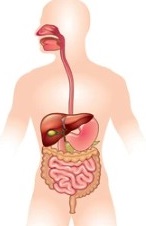The digestive system is a complex system that starts with the mouth and its final organ is the anus. The digestive system is made up of the esophagus, stomach, small intestine, large intestine, rectum, and anus. The digestive system has two main functions: breaking down food into smaller pieces and absorbing nutrients from these particles.

Digestive System Parts
- Mouth – This is the first system in the digestive system where food enters. Food moves from the mouth to the esophagus.
- Esophagus – The esophagus moves food from the throat to the stomach.
- Stomach – The stomach stores and breaks down food until it can be digested and passed on to other parts of the body.
- Small intestine – The small intestine takes digested food and breaks it down further, so it can be absorbed into your body through your bloodstream.
- Large intestine – In the digestive system, large intestine’s job is to absorb water from digested material, which leaves behind solid waste that gets eliminated
Process of Digestion
We feel hunger due to physiological processes in the body. The mouth is where chewing and swallowing begin. Digestion also starts in the mouth, when enzymes break down carbohydrates into smaller sugar molecules. Saliva is the mouth contains an enzyme called amylase, which helps to digest starches.
After this, food goes through a long tube called the esophagus, into the stomach. The stomach churns up food using strong muscles before it moves on to the small intestine. The small intestine is where most of the digestion takes place and where most of our nutrients are absorbed from digested food materials. It’s also where any leftover particles get broken down by enzymes from other parts of our body
Role of Digestive Enzymes
Digestive enzymes are molecules that break down large molecules of food into smaller and more easily digestible components. The main function of digestive enzymes is to break down the large food molecules into smaller ones so that they can be absorbed by the body. Digestive enzymes only work on specific types of food and in specific parts of the digestive tract.
They are produced by different parts of the body and they help with digestion. Digestive enzymes are classified as either exogenous or endo-gastric depending on where they are produced. Exogenous digestive enzymes come from outside of the body, while endo-gastric digestive enzymes come from within the body.
There are two types of exogenous digestive enzymes: microbial and plant-based. Microbial enzymes are found in yogurt, kimchi, sauerkraut, and miso soup. Plant-based ones can be found in fruits like pineapple and papaya or vegetables like broccoli and cabbage.
Digestive System Function
The human body is a network of organs and each organ functions differently. The digestive system breaks down food by secreting enzymes and hydrochloric acid to break down the food’s cell walls. The liver produces bile which helps break down fats in the small intestine. The liver also produces enzymes to help with digestion.
The process of breaking down food starts in the mouth when chewing mixes it with saliva which contains amylase to start breaking down starches. The food then moves through the esophagus where peristalsis pushes it through the stomach and into the small intestine where more enzymes are secreted to break it down even further.
Gastrointestinal tract
The GI (gastrointestinal tract) is a hollow organ ( empty from the inside ) that is joined in a long, twisting tube from the mouth to the anus. The gastrointestinal tract includes the esophagus, stomach, small intestine, large intestine, and rectum.
Above all organs work together and break down food that absorbs by the body in form of nutrients. The GI tract also plays an important role in the immune system by producing antibodies and white blood cells that help protect against infection.
Gastrointestinal disease
In the past, gastrointestinal diseases were not considered to be a major public health concern. However, in recent years, there has been an increase in the number of people being diagnosed with gastrointestinal diseases. The constant rise in the population and unhealthy living style is increasing the incidence of chronic diseases that can lead to gastrointestinal disease.
GI diseases are typically classified into two categories: inflammatory bowel disease and non-inflammatory bowel disease. Inflammatory bowel diseases include Crohn’s Disease and ulcerative colitis while non-inflammatory bowel diseases include celiac disease, gastritis, and pancreatitis.